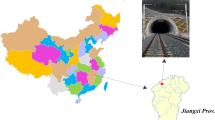Tunnel lining segments can crack or sustain fractures at different stages. It will then affect the stability and structure of the tunnel construction process. Segments are mainly loaded during the installation stage. The main objective of this research is to identify the main factors in the creation of cracks and chipping in segments during the installation stage. By analyzing the collected data, the causes of cracking are investigated such as excessive forces of the TBM jacks, joint dislocation (offset), spacing (gap) in the segmental ring, and defects of the support conditions. Using a statistical analysis of the field data, the interpretation of these causes is discussed. In addition, numerical results are presented to validate the effect of jacking forces on the segments.
Similar content being viewed by others
References
K. Elliott, Precast Concrete Structures, 1st ed, Butterworth-Heinemann, Boston, USA (2002).
C. Hung, J. Monsees, N. Munfah, and J. Wisniewski, Technical Manual for Design and Construction of Road Tunnels – Civil Elements, National Highway Institute, US Department of Transport Federal Highway Administration, Washington, USA (2009).
C. Blom, “Design philosophy of concrete linings in soft soils,” Ph.D. dissertation, TU Delft, Delft, Netherlands (2006).
M. Sugimoto, “Causes of shield segment damages during construction,” Int. Symp. Underground Excavation and Tunnelling, Bangkok, Thailand (2006).
M. Xu and Z. Zhang, “Cause analysis and treatment of segment damage of large diameter shield tunnel,” Chin. J. Undergr. Space Eng., 9, 1705-1712 (2013).
S. Cavalaro and A. Aguado, “Packer behaviour under simple and coupled stresses,” Tunn. Undergr. Sp. Tech., 28, 159-173 (2012).
Y. Yang, B. Zhou, X. Xie, and Ch. Liu, “Characteristics and causes of cracking and damage of shield tunnel segmented lining in construction stage – a case study in Shanghai soft soil,” Eur. J. Environ. Civ. En., 22, 213-227 (2017).
C. Blom, E. J. Horst, and P. S. Jovanovic, “Three-dimensional structural analyses of the shield-driven - green heart Tunnel of the High-Speed Line South,” Tunn. Undergr. Sp. Tech., 14(2), 217-224 (1999).
J. Chen and H. Mo, “Numerical study on crack problems in segments of shield tunnel using finite element method,” Tunn. Undergr. Sp. Tech., 24, 91-102 (2009).
B. Slenders, “Modelling of the assembly phase of shield driven tunnels (in Dutch),” Ph.D. Dissertation, TU Delft, Delft, Netherlands (2002).
L. S. Hsu and C.-T. T. Hsu, “Complete stress-strain behaviour of high-strength concrete under compression,” Mag. Concrete. Res., 46(169), 301–312 (1994).
L. Liao, A. de la Fuente, S. Cavalaro, A. Aguado, and G. Carbonari, “Experimental and analytical study of concrete blocks subjected to concentrated loads with an application to TBM-constructed tunnels,” Tunn. Undergr. Sp. Tech., 49, 295–306 (2015).
R. Burgers, “Non-linear FEM modelling of steel fiber reinforced concrete for the analysis of tunnel segments in the thrust jack phase,” Ph.D. Dissertation, TU Delft, Delft, Netherlands (2006).
S. Cavalaro, C. Blom, A. Aguado, and J. Walraven, “New design method for the production tolerances of concrete tunnel segments,” J. Perform. Constr. Fac., 26(6), 824-834 (2011).
S. Cavalaro, C. Blom, J. Walraven, and A. Aguado, “Structural analysis of contact deficiencies in segmented lining,” Tunn. Undergr. Sp. Tech., 26(6), 734-749 (2011).
S. Cavalaro, C. Blom, J. Walraven, and A. Aguado, “Formation and accumulation of contact deficiencies in a tunnel segmented lining,” Appl. Math. Model., 36(9), 4422-4438 (2012).
J. Chen and H. Mo, “Study on effect of segments erection tolerance and wedge-shaped segment on segment ring in shield tunnel,” J. Zhejiang. Univ. Sc. A., 7(11), 1864-1869 (2006).
F. Gruebl, “Segmental rings-critical loads and damage prevention,” Int. Symp. Underground Excavation and Tunnelling: Effect of Groundwater on Tunnel Stability, Bangkok, Thailand, 9-19 (2006).
M. Herrenknecht and K. Bappler, “Segmental concrete lining design and installation,” Soft Ground and Hard Rock Mechanical Tunneling Technology Seminar, Colorado School of Mines, USA (2003).
H. Mo and J. Chen, “Study on inner force and dislocation of segments caused by shield machine attitude,” Tunn. Undergr. Sp. Tech., 23(3), 281-291 (2008).
Turo, Structural Analysis and Design of Segmental Tunnel Lining of the Line 2 Metro of Tabriz, Tabriz, Iran (2012).
Author information
Authors and Affiliations
Corresponding author
Additional information
Translated from Osnovaniya, Fundamenty i Mekhanika Gruntov, No. 4, July-August, 2021.
Rights and permissions
About this article
Cite this article
Sharghi, M., Chakeri, H., Afshin, H. et al. Analysis of the Possible Cracking and Damages of Tunnel Lining Segments during Installing Stage. Soil Mech Found Eng 58, 287–294 (2021). https://doi.org/10.1007/s11204-021-09741-z
Published:
Issue Date:
DOI: https://doi.org/10.1007/s11204-021-09741-z




